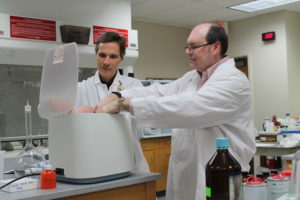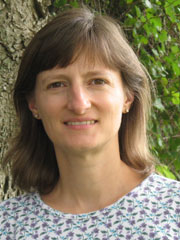UW–Madison School of Pharmacy PharmD student-led analysis finds that just 15 percent of CBD-infused oil, beverages, and other products are labeled correctly
By Katie Gerhards
In 2018, the U.S. Food and Drug Administration approved the first prescription medication derived from cannabis sativa: Epidiolex. Used to treat seizures, Epidiolex is purified formulation of cannabidiol (CBD) and has been proven to significantly lower the frequency of seizures in some patients with devastating epilepsy syndromes such as Lennox Gastaut syndrome, Dravet syndrome and tuberous sclerosis complex.
But for patients who can’t afford a prescription or want to augment an existing antiseizure therapy, can that chocolate bar touting CBD on its label be beneficial? According to a team of researchers from the University of Wisconsin–Madison School of Pharmacy — not likely.
An analysis of 39 CBD products from stores across Southwest Wisconsin, led by fourth-year PharmD student Owen Miller, finds that the majority of these products are inaccurately labeled, and in fact, may contain measurable amounts of THC, which leads to inconsistent and unreliable dosing.
“Unlike traditional prescription medications, there’s nobody regulating this. It’s fallen through all sorts of regulatory cracks.”
—Barry Gidal
“Some of the companies had what they claimed to have, but a lot of them were either over- or very much under-representing the contents of their product,” says Barry Gidal, professor in the School’s Pharmacy Practice Division, who is the senior author on the publication..
Their study, published in Epilepsy and Behavior, used HPLC, or high performance liquid chromatography, to analyze the contents of 39 CBD-infused beverages, oils, and other miscellaneous products, including chocolate bars, honey, coconut oil, transdermal patches, and more. Although not all products specified CBD levels on their labels, just six — 15.4 percent — were accurately labeled.
“Unlike traditional prescription medications, there’s nobody regulating this,” says Gidal. “It’s fallen through all sorts of regulatory cracks.”
Inaccurate labeling
Since the passage of the 2018 Farm Bill — which removes hemp-derived products like CBD from the Controlled Substances Act — more nonprescription products advertising CBD on their labels have started filling up shelves of various retailers. But the U.S. Food and Drug Administration has not yet developed federal guidance surrounding the sale and labeling of CBD, and the UW–Madison School of Pharmacy study spotlights the effects of lacking regulation.
Across all product categories the research team analyzed, beverages were the least likely to be accurately labeled, according to standards established by the US Pharmacopeia (USP) for other drug products. Unfortunately, there is currently no USP guideline for CBD.
Among 21 beverages — like coffee, seltzer, kombucha, water, tea, and even beer — only one was accurately labeled. Seventy-eight percent were over-labeled, meaning they contained less than 90 percent of the CBD they were supposed to contain. And 7 percent were under-labeled, with 110 percent or more CBD than the label indicated.

“Cannabinoids are lipid-soluble and don’t really dissolve in water,” says Gidal “When I started seeing CBD beverages, I realized that there was probably nothing in them, but the products are still being sold at a premium.”
Among 11 analyzed oils, roughly a third were appropriately labeled and another third were under-labeled, with one product containing nearly 130 percent of what its label promised. The majority of miscellaneous products — 67 percent — were over-labeled.
And importantly, many of these products contained detectable levels of tetrahydrocannabinol (THC), which can cause the psychological effects attributed to marijuana. THC was detected in 24 percent of beverages, 55 percent of oils, and 71 percent of miscellaneous products.
The inaccuracy of labeling, particularly regarding THC, could cause unexpected effects on the central nervous system and cause trouble for those who are subject to drug testing.
“This discrepancy in labeling and variability of contents have happened in a lot of different areas of pharmacy, and CBD is just the most recent to go under the microscope because it’s in a less regulated space,” says Ed Elder, director of the School’s Zeeh Pharmaceutical Experiment Station, a collaborator on the project.
‘A real clinical need’
Gidal has long been involved in research relating to Epidiolex. He helped analyze the pharmacokinetics of the drug and in his clinical practice at the William S. Middleton Memorial Veterans Hospital’s Epilepsy Clinic in Madison, Wis., he oversees his patients’ use of it.
“In my practice, I and my colleagues nationwide began to see our patients buying CBD products and taking them at whatever doses were labeled on the product or recommended by the retailer,” says Gidal. “In many cases, patients were reluctant to tell us that they were using these products at all.”
He would hear of patients sometimes spending hundreds of dollars a month on them, and he decided it was time to learn what they were paying for.

“We wanted to do a study here to just look at locally sourced CBD products to see if it matches up with what we’ve been hearing about,” says Gidal. “This study started with a real clinical need to understand what the products are and are not.”
After connecting with Gidal in his first year of the PharmD program, Miller took on the project in 2018 and has collaborated with Elder and Karen Jones, Zeeh Station lab manager.
“There couldn’t have been a better lab to do the analysis in,” says Miller. The Zeeh Station specializes in various aspects of drug development, including stability formulation, and Elder himself holds a seat on one of USP’s expert committees.
“Ed and Karen have been invaluable partners in this research. We are quite lucky to have the Zeeh station as a resource here in the School,” says Gidal.
“We’re here on campus to serve unmet research needs and provide expertise in everything related to pharmaceutical development, including analytical capabilities and making sure the analytical methods are appropriately validated,” says Elder. Part of their mission is also educational, allowing PharmD students like Miller to come in and use the facility.
“I was able to expand this project and had a lot of leeway and freedom; it grew as much as I would take on,” says Miller. For example, it was Miller’s idea to include beverages in the analysis.
His intensive research has been completed through independent study courses with Gidal and is part of the School of Pharmacy’s PharmD Path of Distinction in Research.
“The requirements the Path of Distinction, such as submitting manuscripts to journals and attending meetings, felt like a very natural complement to what I was already doing,” says Miller. “The School has been incredibly supportive of this research in a number of ways, such as through scholarships and course credit.”
Miller has presented this cannabinoids research with a poster at the School of Pharmacy’s PharmD & PharmTox Research Symposium last year.
What’s next for CBD research
Although Miller is graduating in May 2022, both he and Gidal have plans to continue to enhance practitioners’ understanding of CBD. After graduation, Miller will be completing a fellowship in clinical research in neurology at the University of Colorado Denver, focusing on teaching and clinical trials in the area of cannabinoid therapeutics for pain and muscle movement disorders.
He has also helped to frame out an upcoming study with Gidal at the School of Pharmacy to explore CBD’s stability.
“Once you expose CBD solutions to air and light, they begin to break down pretty quickly, creating a concern about product stability,” says Gidal. The study, to be completed with assistance by another PharmD student, will determine how long a bottle of CBD retains its efficacy after it’s been opened.
“Pharmacists and all practitioners need to understand these key questions around dosing, stability, and drug interactions as CBD grows its presence on the market.”
—Barry Gidal
“Right now, there is a pretty short shelf life for the prescription drug Epidiolex,” says Gidal. “Once it’s open, only a matter of weeks until it has to be discarded.”
Miller and Gidal have also pored over patient charts for a clinical review looking at potential drug interactions with CBD, incorporating views from patients in the hospital, and will soon be publishing their results.
“Pharmacists and all practitioners need to understand these key questions around dosing, stability, and drug interactions as CBD grows its presence on the market, especially as it continues to occupy this unregulated space,” says Gidal.